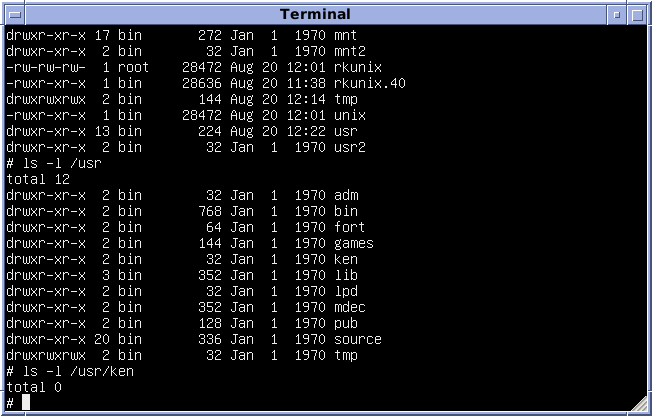SIMH on:
[Wikipedia]
[Google]
[Amazon]
SIMH is a free and open source, multi-platform multi-system
Max Burnet and Bob Supnik, Digital Technical Journal, Volume 8, Number 3, 1996. SIMH was started in 1993 with the purpose of preserving minicomputer hardware and software that was fading into obscurity. In May 2022, the


 SIMH emulates hardware from the following companies.
SIMH emulates hardware from the following companies.
Additional VAX/MicroVAX models for SIMH
Debian Package
FreeBSD Port
UNIX: Old School. Using SIMH to explore UNIX history - Matthew Hoskins
SCSI tape drive emulation for the Raspberry Pi with support for SIMH tape image files
{{Virtualization software 1993 software Free emulation software Linux emulation software MacOS emulation software Windows emulation software Emulation software Multi-emulators
emulator
In computing, an emulator is Computer hardware, hardware or software that enables one computer system (called the ''host'') to behave like another computer system (called the ''guest''). An emulator typically enables the host system to run sof ...
. It is maintained by Bob Supnik, a former DEC engineer and DEC vice president, and has been in development in one form or another since the 1960s.
History
SIMH was based on a much older systems emulator called MIMIC, which was written in the late 1960s at Applied Data Research."Preserving Computing's Past: Restoration and Simulation"Max Burnet and Bob Supnik, Digital Technical Journal, Volume 8, Number 3, 1996. SIMH was started in 1993 with the purpose of preserving minicomputer hardware and software that was fading into obscurity. In May 2022, the
MIT License
The MIT License is a permissive software license originating at the Massachusetts Institute of Technology (MIT) in the late 1980s. As a permissive license, it puts very few restrictions on reuse and therefore has high license compatibility.
Unl ...
of SIMH version 4 on GitHub
GitHub () is a Proprietary software, proprietary developer platform that allows developers to create, store, manage, and share their code. It uses Git to provide distributed version control and GitHub itself provides access control, bug trackin ...
was unilaterally modified by a contributor to make it no longer free software, by adding a clause that revokes the right to use any subsequent revisions of the software containing their contributions if modifications that "influence the behaviour of the disk access activities" are made. As of 27 May 2022, Supnik no longer endorses version 4 on his official website for SIMH due to these changes, only recognizing the "classic" version 3.x releases.
On 3 June 2022, the last revision of SIMH not subject to this clause (licensed under BSD licenses and the MIT License) was forked by the group Open SIMH, with a new governance model and steering group that includes Supnik and others. The Open SIMH group cited that a "situation" had arisen in the project that compromised its principles.
Emulated hardware


 SIMH emulates hardware from the following companies.
SIMH emulates hardware from the following companies.
Advanced Computer Design
* PDQ-3AT&T
* 3B2BESM
* BESM-6Burroughs
* B5500Control Data Corporation
* CDC 1700Data General
* Nova * EclipseDigital Equipment Corporation
*Alpha
Alpha (uppercase , lowercase ) is the first letter of the Greek alphabet. In the system of Greek numerals, it has a value of one. Alpha is derived from the Phoenician letter ''aleph'' , whose name comes from the West Semitic word for ' ...
* PDP-1
* PDP-4
* PDP-7
* PDP-8
* PDP-9
* PDP-10
Digital Equipment Corporation (DEC)'s PDP-10, later marketed as the DECsystem-10, is a mainframe computer family manufactured beginning in 1966 and discontinued in 1983. 1970s models and beyond were marketed under the DECsystem-10 name, especi ...
* PDP-11
* PDP-15
* VAX Family Systems
** MicroVAX I, VAXStation I
** MicroVAX II, VAXStation II
** MicroVAX 3900
** VAX 11/730
** VAX 11/750
** VAX 11/780
** VAX 8600
GRI Corporation
* GRI-909Hewlett-Packard
* 2116 * 2100 * 21MX * 3000Honeywell
* H316 * H516Hobbyist projects
* N8VEMIBM
* 650 * 701 * 704 * 1401 * 1620 * 1130 * 7010 * 7070 * 7080 * 7090/7094 * System/3Intel
* Intel systems 8010 and 8020Interdata
* 16-bit series * 32-bit seriesLincoln Labs – MIT Research Lab
* TX-0Manchester University
* Baby, or SSEMMITS
* Altair 8800 both Intel 8080 andZilog Z80
The Zilog Z80 is an 8-bit computing, 8-bit microprocessor designed by Zilog that played an important role in the evolution of early personal computing. Launched in 1976, it was designed to be Backward compatibility, software-compatible with the ...
versions
Norsk Data
* Nord-100Royal-Mcbee
* LGP-30 * LGP-21Sage Computer Technology
* Sage IIScientific Data Systems
* SDS 940SWTPC
* SWTPC 6800Systems Engineering Laboratories
* SEL-32 both Concept-32 and PowerNode systemsXerox Data Systems
*Sigma
Sigma ( ; uppercase Σ, lowercase σ, lowercase in word-final position ς; ) is the eighteenth letter of the Greek alphabet. In the system of Greek numerals, it has a value of 200. In general mathematics, uppercase Σ is used as an operator ...
References
External links
* *Additional VAX/MicroVAX models for SIMH
Debian Package
FreeBSD Port
UNIX: Old School. Using SIMH to explore UNIX history - Matthew Hoskins
SCSI tape drive emulation for the Raspberry Pi with support for SIMH tape image files
{{Virtualization software 1993 software Free emulation software Linux emulation software MacOS emulation software Windows emulation software Emulation software Multi-emulators